Excelsior’s Dance Halls
Excelsior
This page is about some of the music venues around the turn of the last century in the Excelsior area, on the shore of Lake Minnetonka. The information comes from the book Excelsior’s Waterfront: The History of the Excelsior Commons and Excelsior Docks, written by Scott D. McGinnis (2008). Many thanks to Scott for going through this material with me to clarify all the different venues. His extraordinarily well-researched book is available for $10 at the Excelsior-Lake Minnetonka Historical Society.
NOTE: This page does not include the predecessor to the Ballroom at Excelsior Amusement Park; that information is on the Danceland page.
LAKE MINNETONKA CASINO
The Lake Minnetonka Casino was built on the Docks at the foot of Water Street. This was not a gambling casino, but an entertainment center where people could go for bowling, roller skating, refreshments, dining, boat rental, and to buy sundries and bait, etc.
The $12,000 building was located on lakeshore in front of the Hotel LaPaul (later known as the Excelsior Bay Hotel), leased from the LaPaul family. One of the largest pavilions in Excelsior, it included a six lane bowling alley, billiard parlors, something called Box Ball, and a 60 x 135 ballroom. No intoxicating beverages were allowed. The Grand Opening was held on June 6, 1903. The Casino Orchestra, led by Carl Reidelsberger, provided music every afternoon and evening.
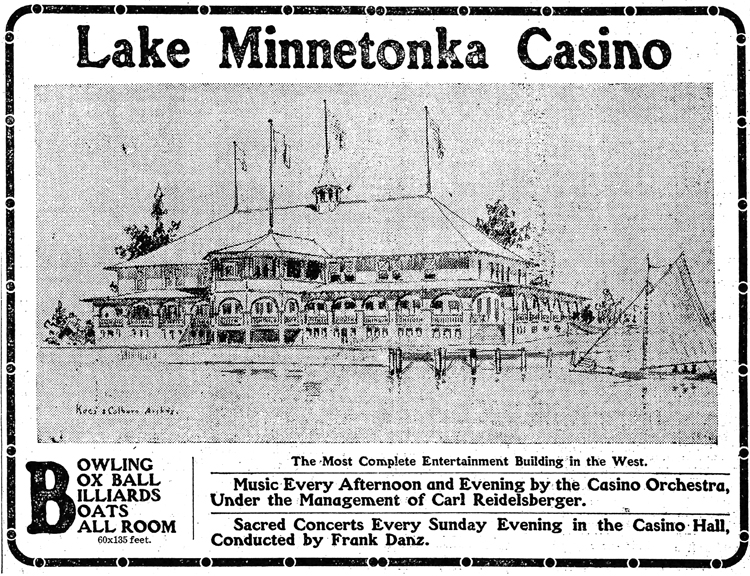
Minneapolis Journal, June 6, 1903
On May 8, 1920, there was an ad for the first dance of the season at the Casino in Excelsior. Music by Squires’ Orchestra; tickets were $1 per Couple. Extra Lady 25 cents. The Casino pavilion was doing a thriving weekend business as well as Saturday night hops (May 28, 1920).
In 1918, Richard and Ruby Golden purchased the Hotel LaPaul and renamed it the Excelsior Bay Hotel. The Goldens, like the LaPauls, felt that the Casino cut into their business at their hotel, and threatened to hold them to their lease, which required the Casino to be removed by January 1, 1923. To forestall this, the Excelsior Park Board made efforts to purchase the property, and the Minnetonka Record reported that the Village had done so, but according to Scott McGinnis’s exacting research, the transaction was never completed.
On December 15, 1922: “The Excelsior Casino, which was built in 1902, will soon be no more. A wrecking crew started work on it this week and the building will be razed to the ground. The work is in charge of Elmer Carlson and Oskar Carlson.”
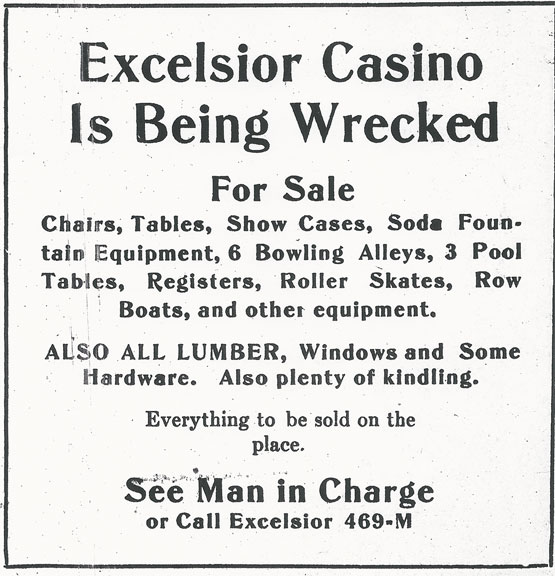
Minnetonka Record, December 22, 1922
The Casino was dismantled and the lumber was used to build a summer cabin up north. The Excelsior Band’s bandstand was moved onto part of the property in April 1923.
In July 1923 it was reported that the water in front of the old casino site was being being dredged and the depression where the casino was was being filled in. “A small mountain of black mud has been thrown up where the casino stood. It is being graded down by the Park Board and will be seeded. A fine green park will be made, extending to the water’s edge, at the foot of Water Street. When completed, it will be a miniature Batteray (sic).” (July 6, 1923)
In about 1938 the bandstand was moved closer to the shore and became the Lakeview Hasty-Tasty Hamburger Stand.
EXCELSIOR COMMONS PAVILION
This building was built by the Excelsior Park Board at the end of the 1923 season to replace the Lake Minnetonka Casino. It was located “on the knoll at the east end of the Commons overlooking the lake. It is a part of the Commons that has not been used regularly. The architecture will be simple and in keeping with the surroundings.” Construction was started in July 1923, by the J.C. Weinholz Construction Co. Of the $9,400 cost, only $1,762 was actually paid to the contractor, even after several lawsuits were filed.
The pavilion measured 40 x 80, and the dance floor was “large enough to accommodate several hundred couples at a time.”
An ad from May 1926 announced the opening of the Excelsior Commons Pavilion Skating Rink, featuring New Skates and Good Music. The proprietor/manager was Walter G. Nelson.
In 1927, it appeared that J.E. McNiece was the proprietor, according to an ad dated June 3, which offered roller skating on Wednesdays, Saturdays, and Sundays.
In 1928 the manager, Eddie Maynard, installed an Orthophonic (amplification device) in the building and opened it for roller skating every evening and Sunday afternoons.
The Excelsior Commons Pavilion only lasted ten years – in February 1933 the Excelsior Fire Marshal ordered it repaired or demolished. The Park Board sold it to L. Mann for $125 it was demolished.
EXCELSIOR BATH HOUSE
The first known commercial Bath House was built in 1879 by Freeman G. Gould. It was located on the Commons and included a restaurant. It was 60 feet long and had 12 changing rooms. Gould also rented boats, and in 1881 he began a ferry service between the bath house to the Lake Park Hotel across Gideon’s Bay.
In 1882 Frank L. Perkins took over the lease and installed a dance floor that was expanded to 32 x 28 in 1884. Dances were not allowed on Sundays.
By 1890 the lease holders were Willard E and Louis D Perkins, and among the amenities of the Bath House was a 40 x 70 dancing platform.
John Thurston leased the Commons Bath House from 1902 to 1910. The Village took over management until about 1946.
STETSON’S BLUE LINE PAVILION
This building was originally built by Llewellyn B. Stetson in 1882 – no music is noted. Stetson had previously operated his Blue Line Boat Company on the western shore of Cedar Lake in Minneapolis. It was proximate to the Stetson House, a hotel that Stetson and his brother George built in 1885.
By 1890 the pavilion was owned by Frank L. Perkins and Walter Baker. Perkins asked Stetson, an architect, for assistance in redesigning the building. The old pavilion and dock were demolished and the new pavilion included a 40 x 70 dance floor.
In 1903/1904 the pavilion was moved down the shore; a newspaper article from May 1904 described it as “rebuilt.” In 1920 the managers were Joos and Francis; an update on the season’s business does not mention dancing at the Blue Line.
The building became the New Blue Line Cafe and was placed on the Amusement Park grounds in May 1938.
The Blue Line Cafe burned down on March 4, 1958.
MORSE DANCE HALL AND BILLIARD HALL
This two-story building was built in July 1876 by William B. Morse, an early area settler and the original owner of Big Island. The building had two stories, and the second floor had a 24 x 30 dance floor. It was a popular Saturday night dancing venue for young folks around the lake. However, Morse had a penchant for serving liquor to minors, being arrested three times in 1890. Then he got in trouble for encroaching on Lake Street, and he apparent had to move his entire building back from the street. The business lasted until about 1906.
MOTOR LINE PAVILION
Colonel William McCrory extended his narrow-gauge Minneapolis, Lyndale, and Minnetonka Railway, known as the “Motor Line,” to Excelsior in 1882. The Railway built a large pier from its tracks into Lake Minnetonka, and in 1886 it contracted with Orpheus S. Gates to build a pavilion on the pier to accommodate train and steamboat passengers. Gates built the new pavilion at the foot of Water Street, adjacent to the Gates and Dunlap Pavilion he had built in 1874. The pavilion was 28 x 100, with two stories. “The upper floor is curtained, forming a popular place for dances, concerts and other entertainments.” (Saturday Evening Spectator, August 1886)
The tracks were purchased by the Minneapolis, St. Paul, and Manitoba Railway in 1887, but due to a number of factors the use of the railway was reduced and the line into Excelsior was abandoned. Gates died in 1887, and the pavilion became the property of Captain Charles May. He lost the line and the pavilion in a property dispute and the pavilion became an eyesore. It was removed in April 1891.
TONKA BAY/FINK’S PAVILION
Some of this is based on speculation, but I think it goes something like this:
The building’s contemporary address is 110 Sunrise Ave., Tonka Bay, Lake Minnetonka.
When was it built?
- County records indicate that it was built in 1900.
- Mr. Fink’s obituary indicates that he owned it starting in 1898.
- If it is the Tonka Bay Pavilion found in the Minneapolis papers, it goes back to 1899.
[Placeholder: An ad from
TONKA BAY PAVILION
A couple of items in July and August 1899 mention a dance and a banquet, both using the Bijou Orchestra.
When the Beach Pavilion opened in 1904, references to the “Tonka Bay pavilion” were probably referring to the new Beach Pavilion. However, one ad for a dance at the Beach Pavilion made a special note that a different dance was being held at the “old” Tonka Bay Pavilion.
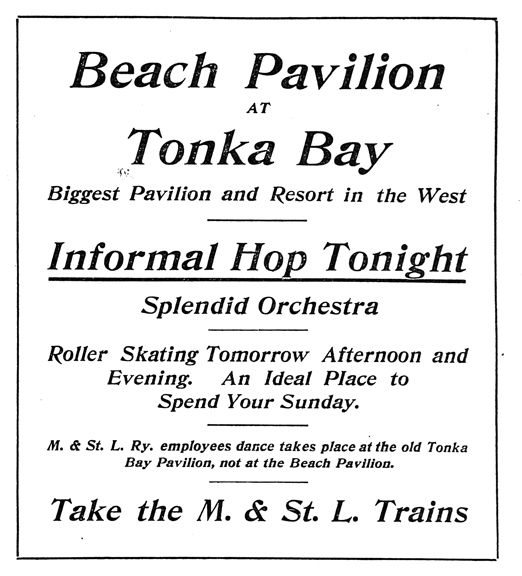
June 18, 1904
FINK’S PAVILION
The obituary of Ferdinand J. Fink says that he was the operator of Curley’s Resort from 1898 to 1935. There are references to Fink’s Pavilion, mostly a site for picnics, in the Minneapolis papers from 1910 to August 29, 1936.
Where was Fink’s? The last reference places it two blocks from Priebe’s Resort. So where was Priebe’s? It appears that it was “across from the roller rink” in 1911. In 1916 it was one block from the end of the Tonka Bay streetcar. Minnie Priebe apparently never actually lived in Minnetonka, but in Minneapolis, where her husband Heinrich “Henry” J. Priebe was a fireman. Although a notice in 1916 said that the place (also known as the Lakeview Inn) was under new management (J.J. Frink), Minnie was still listed in an ad in 1918.) But I digress.
Ferdinand Fink was a Village leader, serving several years as constable. In May 1899 he was appointed postmaster of the new Village. In 1901 he was the caretaker of the Lake Park Hotel, which burned down under suspicious circumstances.
An item dated June 8, 1923, says that Fink was granted a permit to build another dance hall on the beach, but he met with resistance from the community, so it is unclear whether it was actually built.
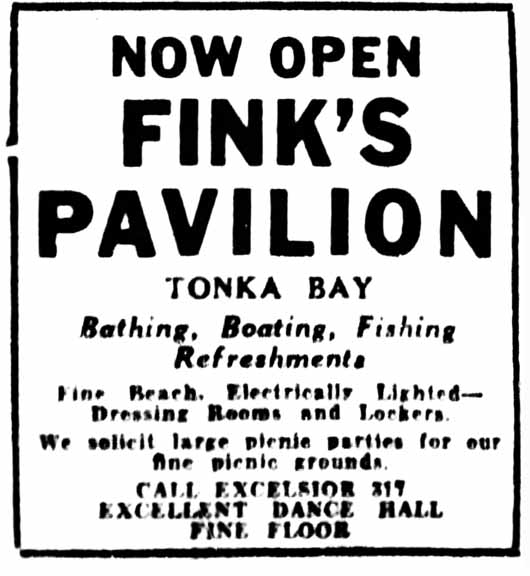
May 27, 1932
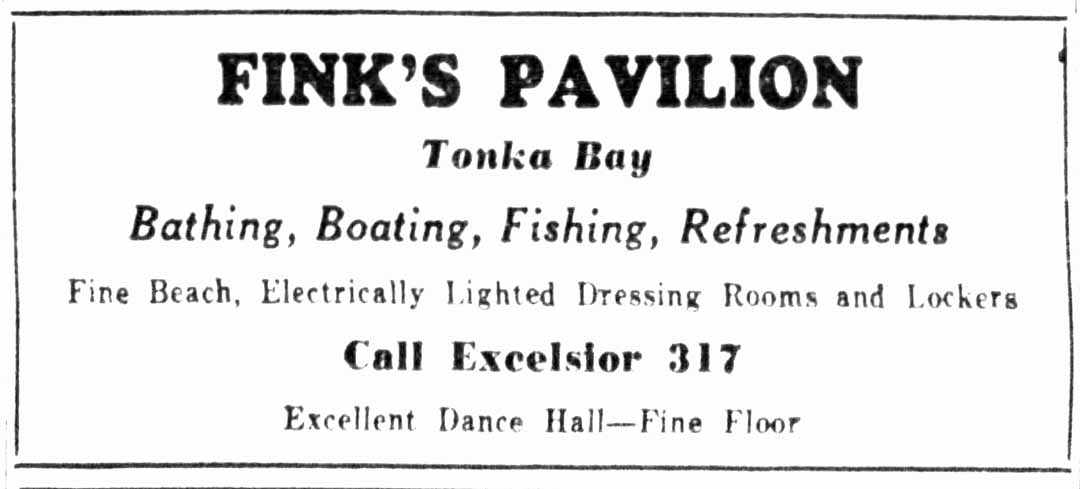
June 16, 1935
TONKA BAY PAVILION
The ad below indicates that Fink’s Pavilion became the Tonka Bay Pavilion in 1936, and that Percy Villa and Sammy Levine were the new owners. A subsequent item indicates that it was located 2 1/2 miles from Excelsior.
In 1939 the manager was LeRoy Johnson. There doesn’t seem to be any indication that it was being used as a dance hall, but there are very few ads in the Minneapolis papers.
In 1950 we learn that the owner had been C. A. Thompson, who sold the Pavilion and bought the Jackson Cafe at Jackson’s Corner, Navarre.
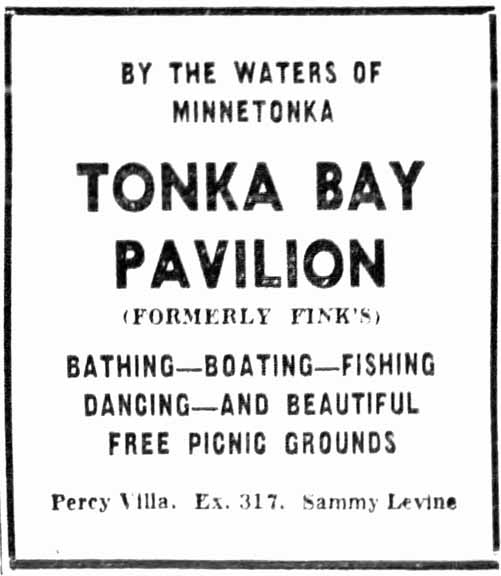
May 27, 1936
County records indicate that 110 Sunrise Drive, built in 1900, is now a privately-owned home.


